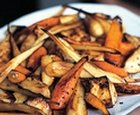|
British Side Roasted Root Vegetables This roasting method adds a touch of glamor to the lowly root vegetable.
Preheat oven to 375. Cut peeled potatoes, parsnips, and carrots into large chunks. Toss them in a large bowl with the oil, herbs, salt and pepper. Turn them out in a single layer on a shallow roasting pan and cook, tossing them halfway through, till tender, about 45-50 minutes. If you’re also preparing roast beef, you can skip the oil, herbs, salt and pepper. About 50 minutes before the beef is finished, drop the vegetables into the roasting pan, stirring and coating them with the beef’s drippings and fat. Yum. Bake till roast is finished (or longer if needed...while the roast rests under a foil tent). |
Tips & Glossary Clotted Cream: a thick yellowish cream made from unpasturized cow's milk. You can make your own, although it's hard to find unpasturized cream in the U.S. Still, you'll find 3 recipes under Scones. All use pasturized cream; try to avoid "ultra" pasturized. Ploughman's Lunch: sounds romantic, like a peasant dish from medieval times, but it's a marketing gimmick from the 1970's! It's become a popular lunch in Britain now: a piece of bread, hunk of cheese, with onion, gherkin, and an apple. Our Ploughman's Soup is a take-off on that name. Roux: (“roo”), paste-like mixture of melted butter and flour, into which liquid is gradually added. Used as a thickening agent for soups and all classic French sauces. Basic Roux: melt 1 part butter and add 1 part flour. Stir continuously till it becomes paste-like. Slowly add whatever liquid your recipe calls for. Tea Time: Afternoon tea became fashionable in the mid-1600's. A light snack with sandwiches and sweets, it's served from 3-5 in a sitting room. High tea, is a light meal served from 5-6 in a dining room. ("High" because the dining table is higher than the low ones in a sitting room.) Yorkshire Pudding: from the northern county of Yorkshire, originating in the early 1700s when flour was more readily available. A pancake like batter is spooned into the drippings of a roast as it cooks. Eaten alongside the roast or as a separate course.
|

